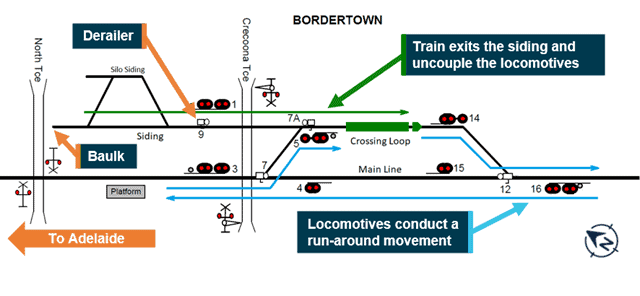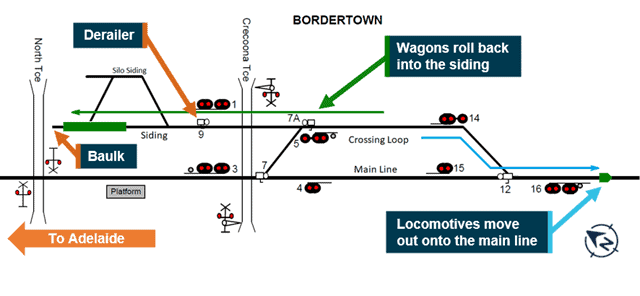30 Freight Train Wagons Roll Away, ATSB Investigation Highlights Omission of Procedural Step

Thirty freight train wagons rolled away unattended for 1,425 meters from a crossing loop before slowing and coming to a stop just before the end of a siding, road, and level crossing at Bordertown, South Australia.
Around 4:00 pm, November 23, 2019, three locomotive drivers signed on at the Bordertown siding to prepare train 2122S for a journey to Adelaide, South Australia. Train 2122S moved out from the siding and onto the Bordertown crossing loop, where a driver detached the two locomotives so they could conduct a run-around movement and reattached the locomotives to the other end of the train consist.

Train 2122S moved out of siding and onto the crossing loop (green arrow). Locomotives detached for a run-around movement so they could be attached to the other end of the train consist (blue arrows). Source: ARTC, modified and annotated by ATSB (Australian Transport Safety Bureau) for clarity.

The locomotives start the run-around movement by moving out onto the main line (blue arrow). The unattended wagons roll back, pass over the level crossing, bounce over the derailer and continue back into the siding (green arrow). Source: ARTC, modified and annotated by ATSB for clarity.
As the locomotives started the run-around movement, the unattended wagons started to roll back towards the siding. The wagons rolled over a level crossing (which operated automatically as designed), bounced over a derailer (signaling infrastructure on the rail) and continued back into the Bordertown siding.
A driver, still in the siding, observed the unattended rolling freight wagons, so ran alongside and commenced applying the handbrake on one of the wagons. The runaway wagons slowed and came to a stop, having rolled unattended for about 1,425 m. The wagons stopped about 47 m from the end of the siding, a road, and level crossing.
There was only minor damage to the derailer, associated rodding, and slight misalignment of sleepers.
What the ATSB found
The ATSB found that, while detaching the locomotives, the brake pipe air taps were closed by the driver on ground, uncoupling the wagons before a full application of the train air brakes by the driver in the lead locomotive. This prevented further reduction of brake pipe air pressure, so the wagon brakes did not fully apply. In addition, handbrakes were not applied to any wagons. Once the locomotives were detached, the lack of air brakes and handbrakes allowed the wagons to roll away on the descending grade.
While not contributing to the incident, the ATSB also found that the device (a baulk) installed at the siding for restraining runaway wagons was likely insufficient to restrain runaway wagons under some conditions.
Key points:
|
What has been done to mitigate or prevent repeat incidents?
Bowmans Rail issued a safety alert requiring uncoupled wagons to have all air exhausted and handbrakes applied when left unattended. The alert also reinforced that all procedures must be adhered to when coupling and uncoupling rollingstock. Additionally, Bowmans Rail has communicated the findings of their investigation and their expectations to train crew, as well as consulted on improvements planned for its Bordertown shunting processes.
The Australian Rail Track Corporation (ARTC) has installed an arrestor bed on the track at the Bordertown dead end, with further works to the arrestor bed planned for late 2020.
What is the safety message came from this investigation?
This incident highlights how omitting a procedural step may result in over-reliance on remaining protective measures. In this case, the non-application of handbrakes increased reliance on the full application of wagon air brakes to prevent a runaway. However, a slight out-of-sequence implementation of the air brake process resulted in only partial application of the wagon air brakes and the subsequent runaway of unattended wagons. It is essential that all procedural steps are undertaken when uncoupling wagons for run-around movements.
Be sure to read the ATSB report in its entirety to learn further safety measures and more.
Founded in 1988, the TapRooT® Root Cause Analysis System solves hurdles every investigator faces
TapRooT® Root Cause Analysis Training System takes an investigator beyond his or her knowledge to think outside the box. Backed with extensive research in human performance, incident investigation, and root cause analysis, TapRooT® is a global leader in improved investigation effectiveness and productivity, stopping finger-pointing and blame, improving equipment reliability, and fixing operating problems.

NOTE: The above picture was taken prior to the pandemic and does not reflect COVID-19 practices that are part of current TapRooT® courses.
TapRooT® Root Cause Analysis Training courses are taught all over the world
System Improvements, the creator of the TapRooT® System, has a team of investigators and instructors with years of extensive training ready to offer assistance worldwide.
If you are interested in learning how to stop repeat incidents, find a 2-Day or 5-Day course; or view the complete selection of TapRooT® courses. We are available to train you and your staff on-site at your workplace; Contact us to discuss your needs. You may also call us at 865.539.2139 to discuss any questions you may have.
Keep in touch to improve your problem-solving skills
We’re continually training, helping you improve your professional root cause analysis skills. Stay current with your TapRooT® Root Cause Analysis skills and training through:
- Following our blog;
- Free newsletters;
- Tuning in to TapRooT® TV Video Sessions or our podcasts;
- Connecting with us on Facebook, Twitter, Instagram, Pinterest, LinkedIn, and YouTube;
- And our annual Global TapRooT® Summit. Registration is now open!



